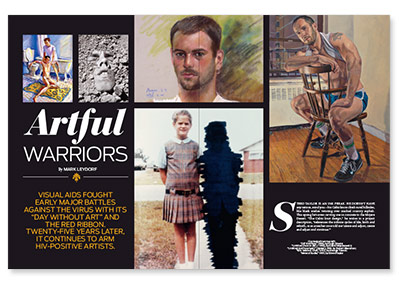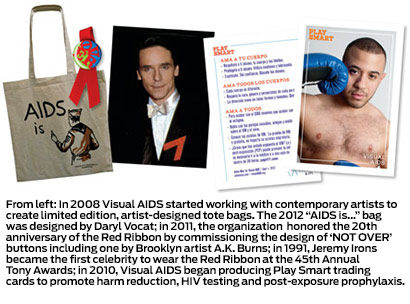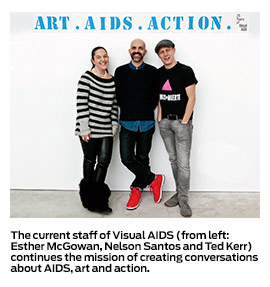
Steed Taylor is an ink freak. He doesn’t have any tattoos, mind you—his Celtic knots climb rural hillsides, like black snakes twisting over cracked country asphalt. This spring he’s even carving one in concrete in the Mojave Desert. “The Celtic knot design,” he writes in a project description, “references the infinite cycles of life, birth and rebirth, or as a teacher once told me ‘create and adjust, create and adjust and continue.’”
Create, adjust, continue. It’s a miracle that Taylor, who learned he was HIV positive in 1985, is inking highways in 2013. “I was 25 and told I’d be dead in two years,” he remembers. At first he wrestled with his shock by helping others, serving as a buddy to people with AIDS and running a support group. “It was a very, very difficult time,” he says. “I tried to keep HIV out of my art, but it kept sneaking in. Eventually, I embraced it and used the cards I was dealt.”
In 1988, an artist living with HIV was a macabre cliché. Today, Taylor is part of a thriving New York City–based arts community called Visual AIDS (VA), which is preparing to celebrate 25 years of protesting, commemorating, and making and sharing art. “Art is our weapon of choice,” says Nelson Santos, VA executive director, quoting the maxim enshrined in its mission statement. “Art still has the power to provoke, maybe make someone question attitudes in a way the policy stuff doesn’t.” The war isn’t over; the army still needs weapons.
Shortly after the first World AIDS Day, December 1, 1988, Tom Sokolowski, then the director of the Grey Art Gallery at New York University (NYU), saw a photo essay that included the late ballet dancer Rudolf Nureyev and other famous people with AIDS. Since the spring of 1988 he and a group of art-world friends had been gathering regularly: Robert Atkins, a writer for the Village Voice; Gary Garrels, a curator at the Dia Art Foundation; and William Olander, who was with the New Museum. The photo essay prompted them to ask, ”What does all this mean? What can we do?” Sokolowski says. The group called their symposium Visual AIDS, choosing a schoolroom pun to underscore the lesson they wanted to teach. “We thought that with our savvy,” Sokolowski says, “we could do something to show that people [with AIDS] were not pariahs.”
“We never thought of ourselves as protesting so much as educating and communicating,” Atkins says. “We left the protests to ACT UP, with which many of us were involved.” Brainstorming for the second World AIDS Day in 1989, another early member, John Perreault, also a writer at the Voice, recalled Vietnam-era protests—art gallery “moratoriums”—in the ’60s. “So John says, ‘Let’s do a day without art.’ And we all thought, oh, that’s good.”
Organizations liked the idea, but many were reluctant to lose a day’s revenue by shutting down. VA suggested that if they couldn’t close, they could do something else appropriate to their institution like covering the art by HIV-positive artists. “What works in New York doesn’t work in Sheboygan,” Sokolowski points out. The first appeal that summer brought enthusiastic yeses from about 40 organizations. By October, when they printed the poster, about 700 institutions had signed on. “I always say here were four guys, then 20, then more, and look what we did! And we did it by the seat of our pants!”
The first Day Without Art actually started the night before World AIDS Day, at New York’s Jewish Museum. December 1 fell on a Friday, and “the Jewish Museum couldn’t be open on the Sabbath—so they did something the night before,” Sokolowski recalls.
The official kick-off was also held that night at the Museum of Modern Art (MoMA). Rushing downtown to the event, the founders hopped in a taxi. “The cabbie turned on the radio, some talk radio station,” Sokolowski says, “and we heard the four of us being interviewed!” The next night, Dan Rather began his own newscast by saying, “This is December first. Today is a Day Without Art.”
The creative community had joined the fight against AIDS, each in its own way; within a few years Classical Action, Broadway Cares, Dancers for Life and countless other efforts were created. “This is what you can do,” Sokolowski says, “if you’re a zealot of a certain sort, and you have energy.”
Next VA put that energy into a humble piece of cloth. Sokolowski says he got the inspiration during the First Gulf War. “I said, ‘Everyone is wearing that yellow ribbon—what if we could do that for AIDS?’” The next month a woman from VA’s Artists Caucus came in wearing the Red Ribbon. “I said I thought it was a little tacky, but everyone else really liked it,” Sokolowski says. At that year’s Tony Awards, in June 1991, actor Jeremy Irons was the first person to wear one on television. “The next day, [gossip columnist] Liz Smith found out what it was all about, and then the ribbon went crazy,” Sokolowski says.
Years later someone from ACT UP told him he didn’t like the ribbon. “I said: I’d just talked to a mother who’d lost her son to AIDS, and she had all of her friends in a church basement making ribbons,” Sokolowski says. “I mean, you didn’t ever see the president of the United States wearing a ‘Silence=Death’ button, but you did see him wearing a Red Ribbon.” Within a few years of the first Day Without Art and the Red Ribbon, VA had created numerous other projects: the Night Without Light, the Visual AIDS Competition, the Electric Blanket. “The list goes on and on,” Atkins says.

It’s amazing to be part of an institution with such a rich history,” says Nelson Santos, who first came to VA in 2000 and has been executive director since 2012. (He’s an artist himself, incidentally; asked what kind of work he makes, he answers: “Not as much as I’d like!”) The agency is housed near the High Line on West 26th Street in a loft just big enough for Santos, his colleagues Esther McGowan and Ted Kerr, and maybe an intern. “We’ve always had a small staff. It’s always been, like, two, maybe two-and-a-half people,” Santos says. “We still manage to get a lot done!”
So they do. “We didn’t want to be that organization that would do something once a year,” Santos says. In addition to events around World AIDS Day, VA organizes a deluge of exhibitions and other programming. Early on, VA produced graphic broadsides with artists such as Barbara Kruger and Glenn Ligon. The era of placards is over, so VA now makes tote bags, which Nelson says have an advantage: “The bag is attached to an individual, so it starts a conversation.” Working with photographers, VA also prints safer-sex trading cards. “They have a sexy, alluring image. You grab it, and there on the back is info about harm reduction, PrEP [pre-exposure prophylaxis]. The card is appealing enough that you might hang on to it, keep it on your nightstand,” Santos says. “These sort of provocations—art can do it. Other things can’t.”
Santos is in frequent contact with VA’s surviving founders. (Bill Olander died of AIDS in 1990.) In the early ’90s, Sokolowski moved to Pittsburgh to run the Warhol Foundation; Garrels went back to curating at the Hammer Museum in Los Angeles and today is at the San Francisco Museum of Modern Art; Atkins returned to cultural criticism and has written several books. “I was never that interested in helping to provide money for art supplies for New York artists,” he says. “While every community has its own AIDS crisis, I was more interested in working from other directions.” And yet art supplies remain an important arsenal. Last year, VA distributed $26,000 in materials grants. In addition, Santos says, 80 percent of VA’s total budget of about $500,000 goes to programming. “Exhibitions and publications have their own costs, but VA also tries to make sure the artists involved are paid.”
Taylor—the artist who tattoos the world—first joined VA in the mid ’90s; a few years later, he joined its board of directors. His work from that period is dark: He’d blow up childhood photos from the ’60s and ritualistically mark himself out. It was a way of making sense of medical jargon and not seeing himself “as a research tool rather than an individual,” Taylor says. The photos were surrounded by quotes from friends and family “telling me what they would miss if I died.”
About the time Taylor was making his excised portraits, VA decided it needed to rebrand Day Without Art. “It was [known as] a day of remembrance and action,” Santos says. “There was always the idea that activism was involved—but early on they worried that they weren’t including living artists.” In 1997, the name was changed to Day With(out) Art. VA began to encourage institutions to do shows with living HIV-positive artists and about AIDS. The adjustment had other dividends: “Covering up artwork was very effective those first few years,” Santos says. “But it was time to change it up.”
Meanwhile, VA has developed its Artist Registry, a virtual gallery that memorializes trailblazers who are gone and that nurtures a growing army of artists who are very much alive. Oils by George Towne rub shoulders with the Lethal Weapons series by Barton Lidice Bene¹ and with fuck-yous from David Wojnarowicz. “More people can see my work,” Taylor says of the archive, “and see it within [the HIV] context and with other artists who share [the same] influences.” At last count, the Registry includes 442 artists—358 living with HIV and 84 deceased—and contains more than 18,000 images. To be in the Artist Registry, Santos says, “the artists only must consider themselves artists—it’s not about gallery shows or anything—and they must be open about their HIV status, because of course it’s a public archive. The work is not always about HIV/AIDS,” he adds, “though in some ways the issue is always present.”
The legacy of artists lost to AIDS remains important. Last year, VA produced its first monograph, documenting the work of Robert Blanchon. Before he died, Blanchon had asked his friend Mary Ellen Carroll to try to catalog his work, organize a traveling exhibition and place it somewhere. It was a tall order, “but together we did it,” Santos says. “We’ve actually fulfilled all of those requests. The work was spread out—we had to go through his black books and call old friends and see who had pieces.” Blanchon’s work is in the collection of the Fales Library at NYU.
VA would like to do the same for the painter Hugh Steers. “You have these artists who weren’t recognized. Where would they be now had they lived?” Santos asks. “At the time Hugh was painting, figural work was out of style, not ‘political’—now it’s hard not to see it as political.” Despite its diligent documentation, the organization was never meant to become a museum. “Of course I’d love to see VA have a physical gallery somewhere,” Santos says. “We do so much programming, it’d be amazing to have a space we could do that in. It just wasn’t our original goal.” He reconsiders. “If someone donates a lottery to us, or MoMA says, Hey, we’ll give you a wing—sure!”
 Film has come to play a larger and larger role in the organization’s programming, especially for Day With(out) Art. Santos was especially taken with Ira Sachs’ short 2010 film Last Address, which visits the homes of people lost to AIDS. “It just seemed like the perfect thing for Day With(out) Art,” Santos says. “Putting up an exhibition is hard for an institution for just one day—film screenings are much more accessible and much more practical.” In 2011, VA screened Untitled, by Jim Hodges, Encke King and Carlos Marques da Cruz; last year it showed Jim Hubbard’s ACT UP documentary United in Anger.
Film has come to play a larger and larger role in the organization’s programming, especially for Day With(out) Art. Santos was especially taken with Ira Sachs’ short 2010 film Last Address, which visits the homes of people lost to AIDS. “It just seemed like the perfect thing for Day With(out) Art,” Santos says. “Putting up an exhibition is hard for an institution for just one day—film screenings are much more accessible and much more practical.” In 2011, VA screened Untitled, by Jim Hodges, Encke King and Carlos Marques da Cruz; last year it showed Jim Hubbard’s ACT UP documentary United in Anger.
Sachs later approached Visual AIDS for help with Queer/Art/Mentorship (Q/A/M), which connects an older queer generation with a younger generation. VA provides meeting space and has nominated members for the program. Just sharing space, Sachs says, “physically links the history and vibrancy of the organization, and the work of HIV-positive artists past and present, to the work of these young queer artists.”
Though the connection with Q/A/M is a relatively new and minor part of VA’s work, Santos finds it satisfying. “We’ve found a lot of young people who are activists, who are picking up the torch,” he says. Good thing, because the war continues.
Sokolowski worries that the virus keeps spreading. “I’m 62 now,” he says. “I guess I’d like to somehow be able to scare the shit out of these young kids.” Santos is optimistic about the generation he calls the Occupy crowd. “There is political movement, an awakening. The dialogue is starting up again.”
As long as there’s HIV, Visual AIDS will be part of that dialogue. “If there’s a cure tomorrow, VA wouldn’t close up shop,” Santos says. “Because we don’t think of it as just history. We’re constantly aware of the now. When we’re speaking of HIV/AIDS we’re speaking about now.”






1 Comment
1 Comment